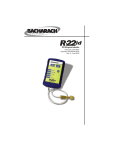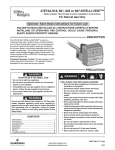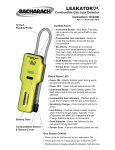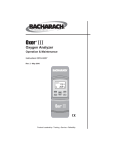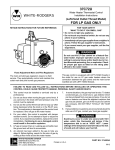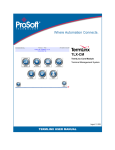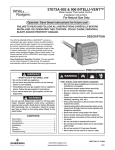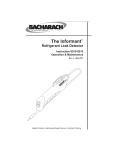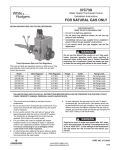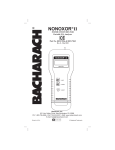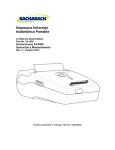Download User Manual - Bacharach, Inc.
Transcript
ODOROMETER Portable Gas Odorant Tester Part Number 5110-0200 Operation and Maintenance Manual Instruction P/N: 0023-9125 Rev. 18 – September 2015 WARNING! Because this instrument is used to detect and monitor materials and conditions which are listed by OSHA or others as potentially hazardous to personnel and property, the information in this manual must be fully understood and utilized to ensure that the instrument is operating properly and is both used and maintained in the proper manner by qualified personnel. An instrument that is not properly calibrated, operated and maintained by qualified personnel is likely to provide erroneous information, which could prevent user awareness of a potentially hazardous situation for the instrument user, other personnel and property. If, after reading the information in this manual, the user has questions regarding the operation, application or maintenance of the instrument, supervisory or training assistance should be obtained before use. Factory assistance is available by calling 724-3345000. World Headquarters 621 Hunt Valley Circle, New Kensington, PA 15068 Ph: 724-334-5000 • Fax: 724-334-5001 • Toll Free: 800-736-4666 Website: www.mybacharach.com • E-mail: [email protected] ODOROMETER WARRANTY BACHARACH, Inc., warrants to Buyer that at the time of delivery this Product will be free from defects in material and manufacture and will conform substantially to BACHARACH Inc.’s applicable specifications. BACHARACH’s liability and Buyer’s remedy under this warranty are limited to the repair or replacement, at BACHARACH’s option, of this Product or parts thereof returned to Seller at the factory of manufacture and shown to BACHARACH Inc.’s reasonable satisfaction to have been defective; provided that written notice of the defect shall have been given by Buyer to BACHARACH Inc. within one (1) year after the date of Delivery of this product by BACHARACH, Inc. BACHARACH, Inc. warrants to Buyer that it will convey good title to this Product. Bacharach’s liability and Buyer’s remedy under this warranty of title are limited to the removal of any title defects or, at the election of Bacharach, to the replacement of this Product or parts thereof that are defective in title. The warranty set forth in paragraph 1 does not apply to parts the Operating Instructions designate as having a limited shelf life or as being expended in normal use. THE FOREGOING WARRANTIES ARE EXCLUSIVE AND ARE GIVEN AND ACCEPTED IN LIEU OF (i) ANY AND ALL OTHER WARRANTIES, EXPRESS OR IMPLIED, INCLUDING WITHOUT LIMITATION THE IMPLIED WARRANTIES OF MERCHANTABILITY AND FITNESS FOR A PARTICULAR PURPOSE: AND (ii) ANY OBLIGATION, LIABILITY, RIGHT, CLAIM OR REMEDY IN CONTRACT OR TORT, WHETHER OR NOT ARISING FROM BACHARACH S NEGLIGENCE, ACTUAL OR IMPLIED. The remedies of the Buyer shall be limited to those provided herein to the exclusion of any and all other remedies including, without limitation incidental or consequential damages. No agreement varying or extending the foregoing warranties, remedies or this limitation will be binding upon Bacharach, Inc. unless in writing, signed by a duly authorized officer of Bacharach. Batteries, being expendable items, are excluded from the terms of this warranty. Page 2 Instruction 0023-9125 ODOROMETER OPERATING AND MAINTENANCE INSTRUCTIONS for the ODOROMETER 1. APPLICATION The ODOROMETER is a portable instrument that can be used by gas companies to check the odorization of the gas being distributed. The instrument provides an easy method of determining the odor intensity of a gas stream at any convenient point in the gas distribution or transmission lines, and is a faster method of determining odor levels at high or low gas-air concentrations than the room-test method. The range of testing on the standard instrument is from one-twentieth of 1% to slightly over 1% gas in air. This range enables the operator to check the accepted gas concentrations for the detection of an odorant in natural gas. The ODOROMETER may also be used to perform natural gas odor intensity tests in accordance with ASTM D 6273-98. (ASTM is the American Society for Testing and Materials.) 2. DESCRIPTION The ODOROMETER uses a constant-speed, motor-driven blower to produce a constant flow of air, which is discharged from a glass SNIFFING FUNNEL through an opening in the top of the case, where the operator can sniff it conveniently for the presence of detectable odor. The gas to be tested is supplied to the instrument under its own pressure and metered by a FLOWMETER (also known as a Rotameter) and needle valve. The concentration of gas in the effluent air is determined from the FLOWMETER reading by reference to the calibration chart on the inside of the front cover. The instrument components are mounted on an anodized aluminum panel which, in turn, mounts inside an anodized aluminum case. All metal and instrument surfaces have been chosen so that no outgas problems will occur. Make sure not to use any chemicals on the instrument that would give off residual odors. The ODOROMETER is a DC model completely independent of the power line and takes power from a battery pack consisting of five size D carbon zinc cells. Do NOT use alkaline batteries. This model is adjusted at the factory for proper blower speed and contains a front panel POWER LED which indicates that the unit is working properly. NOTE: Two older versions of the ODOROMETER, an AC and DC model are still in use, and supported by Bacharach Inc. The AC model uses a shaded-pole constant-speed motor to drive the blower, and the instrument is equipped with a line cord for convenient connection to any 115 volt 60 cycle power source. The blower speed of the DC model is controlled by a rheostat and is set using the reading of the built-in milliammeter. Because there are slight differences in the three models, the older models will be referred to in Appendix A, which only needs to be referenced when using one of these older models. 3. OPERATING INSTRUCTIONS 1. Make sure batteries are in place. (See Appendix A for AC models.) 2. The gas supply should be connected to the inlet fitting on the front panel, and pressure should be below 5 psig. Connection should be made with aluminum or plastic tubing only; do not use copper or rubber, as these tend to remove odorant compounds. A 6 foot length of suitable plastic tubing is supplied with the instrument. 3. Where possible, tests should be run in an odor and draft free area. 4. Set the instrument on a level bench or desk. Swing the handle down and the top cover open. Switch the unit "ON" (clockwise). The green POWER LED should light (see Appendix A for older models). Instruction 0023-9125 Page 3 ODOROMETER NOTE: If the LED goes out after a few seconds, replace the batteries. 5. The GAS INLET NEEDLE VALVE is located in the center of the panel. Open the valve slowly while sniffing the air being discharged from the SNIFFER FUNNEL opening in the top of case. 6. The observer must be careful to hold his nose within one inch of the SNIFFING FUNNEL to avoid dilution with the surrounding air (placing the upper lip on the handle will allow the nose to be centered about one inch above the SNIFFING FUNNEL). 7. Odor level rating must be based on the first sniff or two because the olfactory senses fatigue rapidly with continued exposure to an odor. 8. Between sniffs the observer should breathe deeply but slowly through his nose to “regenerate” his perception. Page 4 Instruction 0023-9125 ODOROMETER 4. THRESHOLD ODOR DETERMINATION 1. Have the observers sniff the unodorized air stream. 2. Adjust the gas flow rate to the estimated threshold value and let the observers sniff again to see if they can smell any foreign odor. 3. Adjust the gas concentration upward or downward, as indicated by the above test, and have the observers sniff again. 4. Repeat this procedure until the threshold value is obtained for each observer. It is best to take several readings on both sides of the threshold and to run an occasional blank using air with no added gas. 5. Calculate the average threshold value of each observer. Then calculate the total average value, using these individual averages. This procedure is advisable because considerable variation is found among individuals in detecting threshold value. Thus, if the observers take different numbers of readings, a “straight” average of all these values would give more weight to the observer with the larger number of readings. 6. It is essential for this type of determination that the odor level rating be based on the first sniff only, because fatigue is very rapid in this range. 5. ODOR CHARACTERISTICS AT STANDARD CONCENTRATION 1. Have the observers sniff the unodorized air stream. 2. Adjust the gas rate to the desired concentration. 3. Have the observers sniff the effluent air stream, rating the odor intensity as: (1) absent (2) barely detectable (3) readily detectable (4) strong (5) very strong (obnoxious). 4. If desired, a description of the character of the odor, such as onion, garbage, refinery, etc., can also be obtained. 5. Repeat the test after a short time to check the first determination. 6. RANGE OF MEASUREMENT The instrument has two ranges, obtained by using a lightweight glass and a heavier metal float, both in the same metering tube. Take readings on the glass float when both are within the range of measurement; take readings on the metal float when the glass float reaches the top of the tube. Useful ranges are approximately 0.04 to 0.4% for the glass float, and 0.2 to 1.1% for the metal float. When taking readings, observe the FLOWMETER graduation corresponding to the bottom of the ball float. Find the gas concentration corresponding to this reading by looking at the calibration chart on the inside of the front cover. This chart has been drawn to give the percent gas concentration over the useful ranges for natural gas with a specific gravity of 0.620 relative to air. Concentrations of gases of other densities may be read using the correction factors shown on the graph below the calibration chart. Instruction 0023-9125 Page 5 ODOROMETER 7. MAINTENANCE The FLOWMETER tube and floats must be kept clean to prevent sticking of the floats in the tube. To disassemble, press the sides of the plastic cover and pull out. Remove the spring lock clip at the top of tube, lift the tube connector and pull tube out by lifting from the bottom connectors. The tube and floats can be washed in alcohol, trichloroethylene or other solvent. Page 6 Instruction 0023-9125 ODOROMETER 8. HOW TO USE THE ODOROMETER GAS CALIBRATION CHART When the odor (mercaptan) in gas has been detected, observe the reading indicated by the FLOWMETER float. Depending on the range required, use either the upper glass float (colored) for values 0.04 to 0.4% or lower metal float (silver) for values 0.2 to 1.2%. EXAMPLE: FLOWMETER (silver float) indicates 70; use second curve and observe that percent gas indicated by the chart is 1.1% (% GAS IN ODOROMETER EFFLUENT). If specific gravity of gas under test is 0.620, the correct percentage of gas is as noted on the curve (1.1%). If specific gravity differs, use the CORRECTION CHART below. EXAMPLE: Specific gravity of gas under test is 0.55, the correction factor noted on the chart is 1.06. The correct gas concentration is obtained by multiplying the following: 1.1% x 1.06 = 1.166% (Gas in ODOROMETER effluent). NOTE: The chart below is intended as an example only and does not reflect the calibration of your instrument. See actual calibration graph on your instrument. Your ODOROMETER was calibrated against standards traceable to the National Institute of Standards and Technology (NIST) prior to its shipment from the factory. To ensure the instrument’s continued accuracy and reliability, Bacharach recommends periodic calibration by an authorized Bacharach Service Facility. For best results, the instrument should be initially calibrated after no longer than one year of service. Thereafter, the calibration interval should be set as needed to ensure continued reliability. If calibrated by a Bacharach Service Facility, the assigned interval will be based upon the instrument’s condition as received, in or out-of-tolerance and degree of drift since the last calibration. Bacharach recommends that service on portable instruments, in or out of warranty, be performed at one of our Service Centers. Should service be required, please pack the instrument carefully, include all necessary identifying papers (with description of service needed), and ship prepaid to one of the below locations. United States Canada Bacharach Sales/Service Center 621 Hunt Valley Circle New Kensington, PA 15068 Phone: 724-334-5051 Fax: 724-334-5723 Email: [email protected] Bacharach of Canada, Inc. 20 Amber St. Unit #7 Markham, Ontario L3R SP4 Canada Phone: 905-470-8985 FAX: 905-470-8963 E-mail: [email protected] APPENDIX A - OLDER VERSIONS OF THE ODOROMETER 1. Instruments designed to operate from AC will operate from any 115 volt, 60 Hz power source. 2. For the DC model, start motor by turning switch clockwise to “ON” and rotating the knob clockwise until air flow is achieved. Set ammeter to red mark for proper amount of air flow. For the AC model, just plug in line cord and turn on switch to start air flow. Pilot light will indicate that power is connected to motor. Instruction 0023-9125 Page 7 ODOROMETER Bacharach, Inc. shall not be liable for errors contained herein or for incidental or consequential damages in connection with the furnishing, performance, or use of this material. No part of this document may be photocopied, reproduced, or translated to another language without the prior written consent of Bacharach, Inc. Copyright © 2005-2015, Bacharach, Inc., all rights reserved. ® BACHARACH is a registered trademark of Bacharach, Inc. All other trademarks, trade names, service marks and logos referenced herein belong to their respective owners. Headquarters 621 Hunt Valley Circle, New Kensington, PA 15068 Ph: 724-334-5000 • Fax: 724-334-5001 • Toll Free: 1-800-736-4666 Website: www.mybacharach.com • E-mail: [email protected] Printed in U.S.A. Page 8 ® Registered Trademark of Bacharach Inc. Instruction 0023-9125








